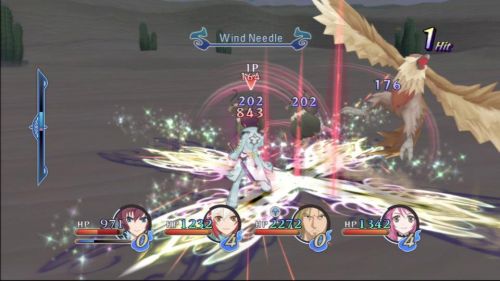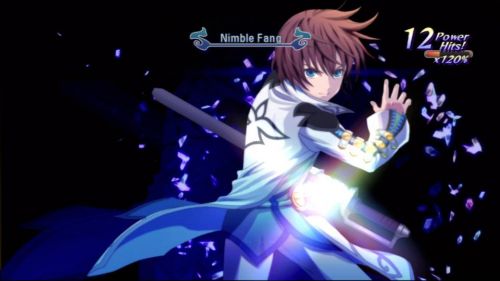The combat is both familiar and radically different from other Tales games. If one is watching the combat, there’s still a party running around smacking people/monsters and casting spells. On the technical side, though, there’s a whole lot different about Graces, which I believe is the game’s strongest point. Like all Tales games, however, the battle system is (or at least can be) pretty complex. Let me try to explain it.

Now hold on, this is going to get a little intense. Graces does away with the normal TP system (TP was like mana in other RPGs). Instead, characters get CC (Chain Capacity), which acts kind of like an energy system from other RPGs. CC is used for two different kinds of Artes: Attack Artes (A-artes) and Burst Artes (B-artes). B-artes are the classic spells that we’re used to in a Tales game (e.g. Demon Fang, First Aid, etc.). These are triggered by first hitting the circle button to put you in B-artes stance, then using your personally mapped B-artes buttons to trigger your desired spell (e.g. L-stick down Circle). A-artes are attack chain artes which are triggered through normal auto-attacking with the X button. Each character can get up to a 4-combo chain with each step in the combo costing more CC (1st step costs 1CC, 2nd step costs 2CC, etc.). You can get different A-artes at different steps in the combo by using the X button in conjunction with different directions on the left analog stick. So, for example, down X may yield a different attack than up X if you’re at the 2nd step of your combo. You can also weave A-artes and B-artes together to get effect. The further along you are in your A-artes chain, you get faster cast time on your B-artes. You can interpose B-artes in between your A-artes without interrupting your A-artes combo. Again, though, you will need to have enough CC to execute any of your artes. You can get CC back by doing things like dodging, flanking, or just waiting for it to come back (it regenerates pretty fast).

You know you did something fancy when you get hand-drawn art in the middle of combat
And that’s just the basic combat. There’s also an Eleth gauge which controls Eleth Burst/Break and gives you access to things such as Mystic Artes. There’s a resistance/vulnerability system for the enemies you encounter. There’s a ton of stuff that I honestly just ignored for my own sanity’s sake. The depth of combat in Graces is there for players who want to master it. It can also be as simple as spamming X to attack and using O to cast spells if your friend wants to hop into the game when you’re playing it. The flexibility for varied skill and knowledge between different players is a great asset to the Tales series, and Graces does a great job of preserving that. Graces has also made it easy to swap between combatants during a fight. Players can use the D-pad to swap to any other character that is not currently being controlled by another player.